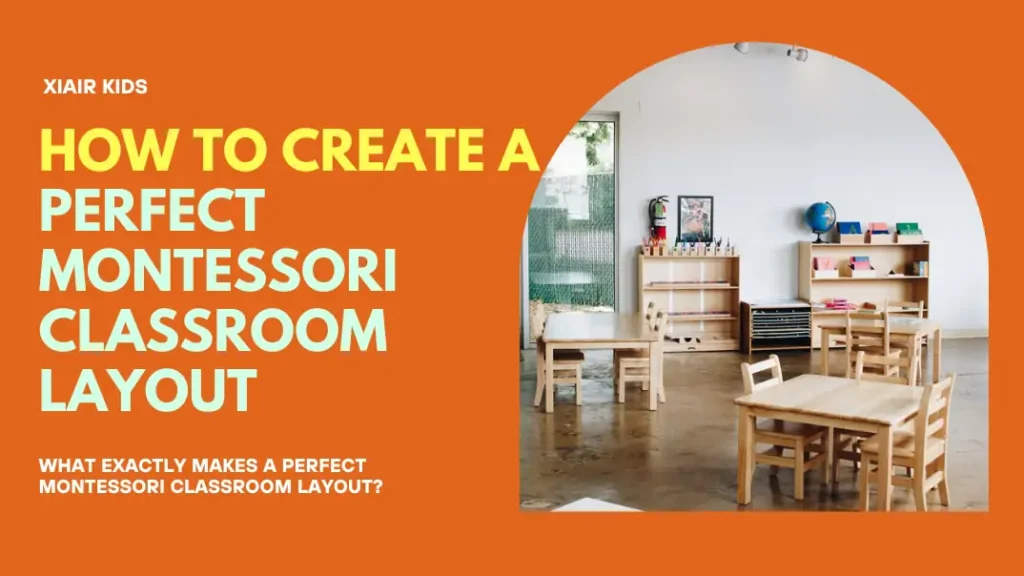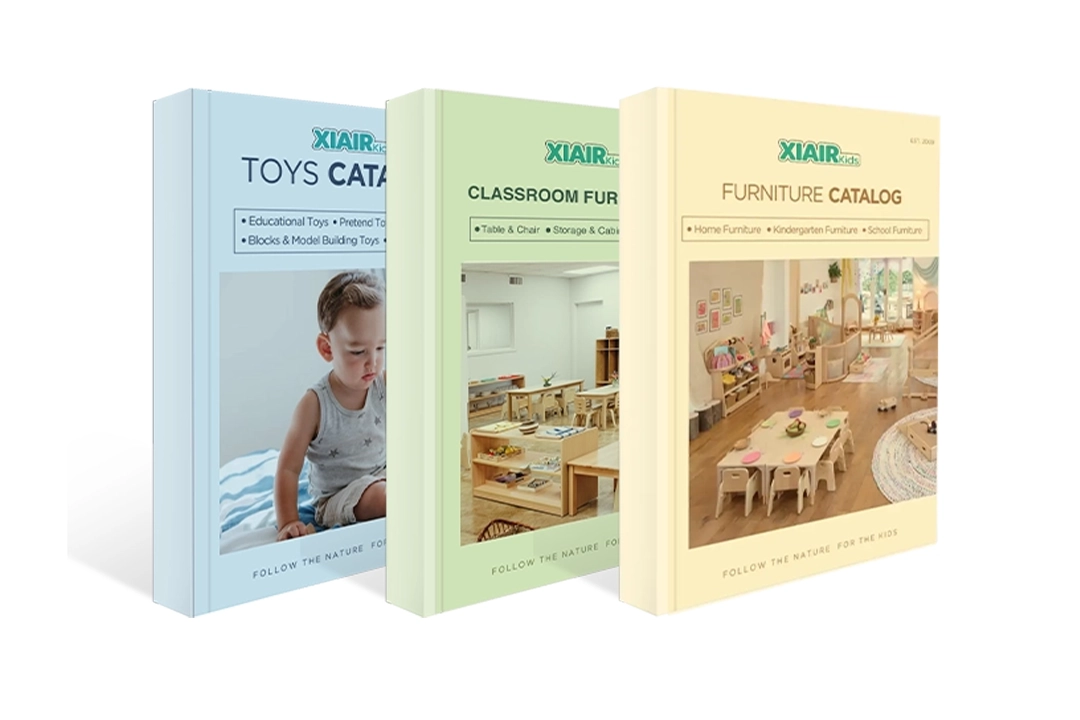Creating the ideal Montessori classroom layout can be a challenging task. It requires careful planning to ensure the space is conducive to learning and aligns with Montessori principles. But what exactly makes a perfect Montessori classroom layout? Many educators and parents are drawn to Montessori education because of its focus on fostering independence, creativity, and a love of learning. The classroom environment plays a crucial role in achieving these goals, as it is meticulously designed to support the developmental needs of each child.
A well-designed Montessori classroom layout is carefully crafted to promote independence, creativity, and a love of learning. It includes well-defined areas for various activities, uses natural light, and incorporates child-sized furniture and Montessori learning materials.
The Montessori method emphasizes the importance of a prepared environment, encouraging exploration and self-directed learning. The classroom layout must be intentional, allowing children to choose their activities while ensuring that each element within the space serves a specific educational purpose. Understanding the core principles behind Montessori classroom design can help you create an environment that fosters children’s academic, social, and emotional growth.
몬테소리 교실 배치의 주요 특징을 알아보고 이를 실제 공간에 구현하는 방법을 알아보세요.
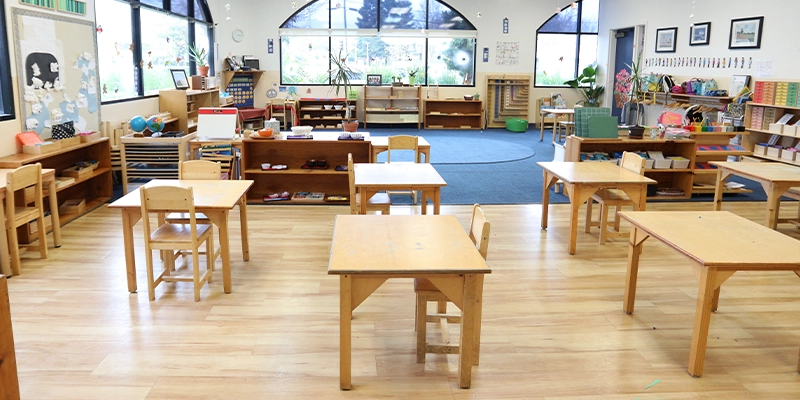
Before diving into the specific steps of setting up a Montessori classroom layout, it is essential to understand the key principles that guide every design choice.
Key Principles Behind a Montessori Classroom Layout
The Montessori classroom layout is deeply rooted in the educational philosophy developed by Dr. Maria Montessori. Every aspect of the layout—from furniture arrangement to material selection—is purposefully designed to foster independence, curiosity, and a love of learning.
One of the core principles is child-centered design. In a Montessori classroom layout, everything must be scaled to a child’s size and developmental stage. Low shelves, small chairs, and reachable materials empower children to explore and engage with their environment freely, without constant adult intervention.
Another critical concept is order and accessibility. A Montessori classroom layout ensures that every item has a designated place. This sense of order helps children develop internal organization skills, promotes self-discipline, and reduces distractions. When children can easily find and return materials on their own, they build responsibility and confidence.
Freedom within limits is another foundational idea. The Montessori classroom layout encourages free movement and independent choice, but within a thoughtfully prepared environment. Defined learning areas and clear pathways ensure that while children have freedom, the space still supports purposeful activity and focused concentration.
Lastly, the Montessori approach values connection with nature. Natural lighting, soft colors, wooden materials, and even indoor plants are standard features of a well-designed Montessori classroom layout. These elements create a calm and inviting atmosphere that nurtures emotional well-being and cognitive development.
Understanding these principles provides a strong foundation for creating a Montessori classroom layout that truly supports children’s holistic development.
교실 디자인
A well-designed classroom not only looks aesthetically pleasing but also functions efficiently. Each element, from the furniture to the decorations, should serve a purpose and contribute to the overall learning experience. Flexible spaces that can be easily rearranged allow for various teaching methods and learning activities, adapting to the needs of students.
전체적인 레이아웃은 깔끔하고 정돈되어 있어 평온함과 집중력을 높여줍니다. 이러한 환경은 아이들이 안정감을 느끼고 스스로 탐구하고 학습하도록 돕습니다. 식물이나 자연광과 같은 자연 요소를 활용하면 교실 분위기를 더욱 편안하고 매력적으로 만들 수 있습니다.
Critical Elements of Montessori Classroom Design
- 자연광과 환기: 밝고 통풍이 잘되는 분위기를 조성하면 아이들이 주변 환경과 더 친밀감을 느끼고 기분과 집중력이 향상됩니다.
- 어린이용 가구: 가구 어린이의 크기에 비례하여 편안함과 접근성이 높아야 하며, 어린이가 주변 환경과 쉽게 움직이고 상호작용할 수 있어야 합니다.
- 정의된 학습 영역: 다양한 과목과 활동을 위한 표시된 공간은 아이들이 작업 사이를 원활하게 전환하고 각 위치의 목적을 이해하는 데 도움이 됩니다.
교실 내 이동의 흐름을 고려하세요. 아이들은 답답함이나 제약 없이 자유롭게 여러 공간을 이동할 수 있어야 합니다. 이러한 유동성은 아이들의 자연스러운 호기심과 탐구심을 북돋아 줍니다. 또한, 아이들이 개별 학습이나 휴식을 위해 쉴 수 있는 조용한 공간을 설계에 포함하여 사회적 상호작용과 고립에 대한 아이들의 욕구를 충족해야 합니다.
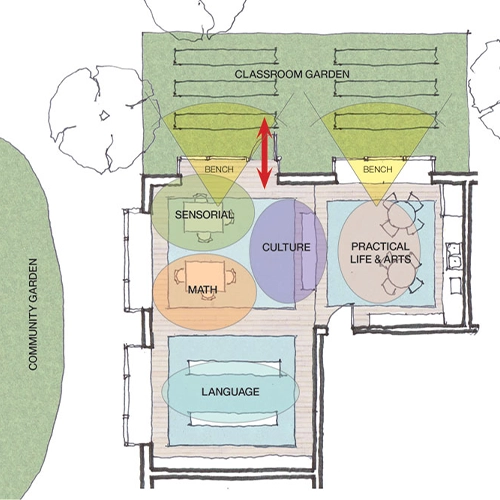
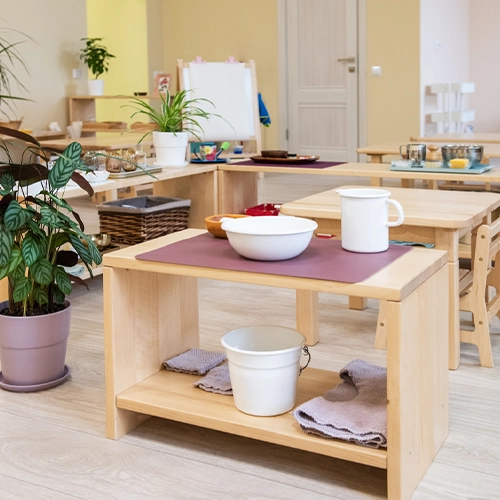
몬테소리 학습 자료
몬테소리 학습 자료는 완벽한 교실 환경을 조성하는 데 필수적입니다. 이러한 자료는 스스로 교정하고 자율 학습을 장려하도록 설계되었습니다. 아이들이 쉽게 접근할 수 있어야 하고, 낮은 선반에 진열되어야 하며, 교과 영역별로 정리되어야 합니다. 각 자료는 정해진 자리에 있어야 하며, 질서를 유지해야 합니다.
The uniqueness of Montessori materials lies in their ability to teach complex concepts in a tangible way. For example, math materials often involve physical objects that children can manipulate to help them understand abstract concepts. This hands-on approach makes learning more engaging and aids in better knowledge retention. The materials are also designed to grow with the child, offering increasing levels of difficulty and complexity.
- 실용 생활용품: These materials teach everyday skills, such as pouring, spooning, and cleaning, promoting motor skills, concentration, and independence.
- 감각적 자료: Sensorial materials refine the senses, helping children understand concepts such as size, shape, color, texture, sound, and smell.
- 언어 자료: Language materials support reading, writing, and communication by utilizing tools such as movable alphabets and sandpaper letters.
- 수학 자료: Math materials make abstract concepts tangible, covering concepts such as counting, addition, subtraction, and more, using tools like number rods and bead chains.
- 문화재: These materials promote global awareness, encompassing geography, history, science, and the arts through the use of maps, globes, and puzzles.
- 미술 및 음악 자료: Art and music materials foster creativity through the use of paints, clay, musical instruments, and rhythm activities.
- 과학 재료: 과학 자료는 생물학, 물리학, 지구과학의 기본 개념을 소개하여 탐구와 발견을 장려합니다.
- 운동 재료: Movement materials, including balance beams, climbing structures, and yoga mats, support physical development.
- 사회정서적 학습 자료: SEL materials help develop interpersonal skills and emotional regulation through the use of emotion cards and cooperative games.
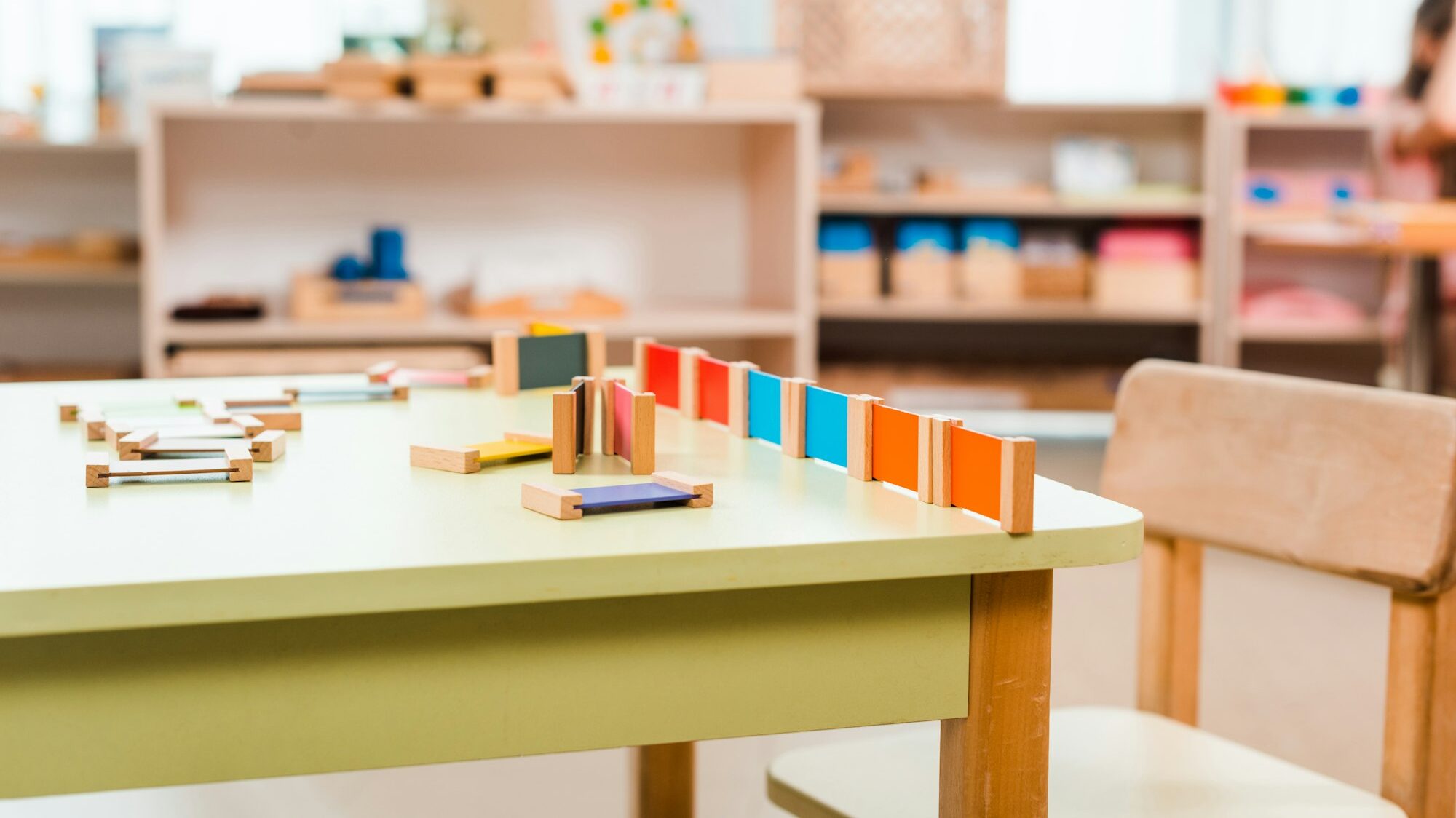
“가이드”로서의 교사
몬테소리 교실에서 교사는 전통적인 교육자라기보다는 안내자 역할을 합니다. 이러한 역할은 교실 배치에 영향을 미칩니다. 교사는 아이들을 자유롭게 돌아다니며 관찰할 수 있는 충분한 공간을 확보해야 합니다. 또한, 아이들이 혼자 또는 소그룹으로 활동할 수 있는 공간을 마련하여 자율적인 활동을 지원해야 합니다.
몬테소리 교실에서 교사는 모든 학생을 명확하게 볼 수 있어야 합니다. 이러한 가시성은 교사가 방해하지 않고 필요할 때 관찰하고 개입할 수 있도록 해줍니다. 가구 배치는 교사가 진정으로 지도가 필요할 때만 개입할 수 있도록, 이러한 방해 없는 관찰을 용이하게 해야 합니다.
교사 책상은 최소한으로 배치하고 눈에 잘 띄지 않는 곳에 두어야 합니다. 이러한 배치는 교실이 아이들의 활동에 집중하는 공동의 공간이라는 인식을 강화합니다. 교사의 역할은 학습 과정을 주도하기보다는 아이들이 자신의 잠재력을 발견하도록 이끄는 것입니다.
다양한 연령대 그룹
몬테소리 교실에는 종종 다음이 포함됩니다. 다양한 연령대 그룹. This diversity promotes peer learning and social development. The classroom layout should accommodate various age groups, with materials and activities tailored to different developmental stages.
Older children can mentor younger ones, sharing their knowledge and reinforcing the younger ones’ learning. This dynamic fosters a collaborative and supportive learning environment, where children learn from one another and the teacher.
모든 연령대의 성과를 기념하는 요소를 활용하세요. 다양한 연령대의 아이들의 작품을 전시하면 다른 사람들에게 영감과 동기를 부여할 수 있으며, 성공을 공유하고 기념하는 분위기를 조성할 수 있습니다.
배려하는 커뮤니티
Creating a caring community is at the heart of the Montessori philosophy. The classroom layout should facilitate social interaction and a sense of belonging. Include areas where children can gather for group activities, discussions, and celebrations.
교실은 아이들이 안전하고 소중하게 여겨진다고 느낄 수 있는 곳이어야 합니다. 이러한 안정감은 효과적인 학습에 필수적입니다. 그룹 좌석 공간이나 아늑한 공간처럼 사회화를 촉진하는 요소들을 활용하면 탄탄한 교실 공동체를 형성하는 데 도움이 됩니다.
교실 공동체의 다양성과 관심사를 반영하는 시각적 요소를 포함하세요. 사진, 미술 작품, 문화 유물은 공간을 더욱 개인적이고 포용적인 공간으로 만들 수 있습니다. 또한 이러한 요소들은 다양한 문화와 경험에 대해 토론하고 배우는 기회를 제공합니다.
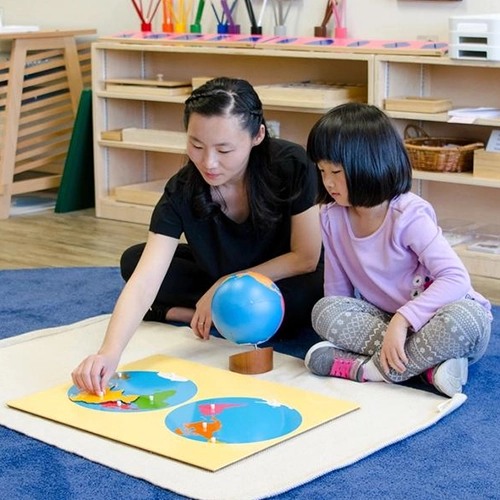
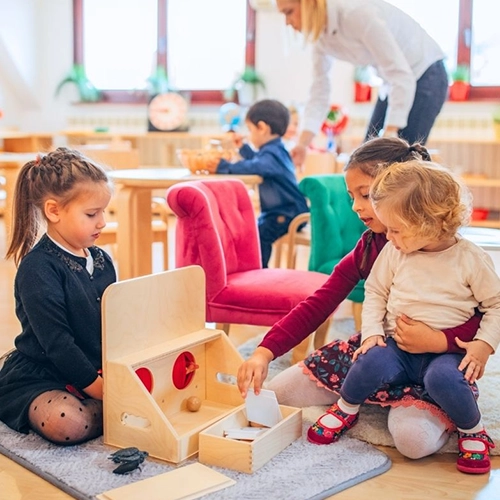
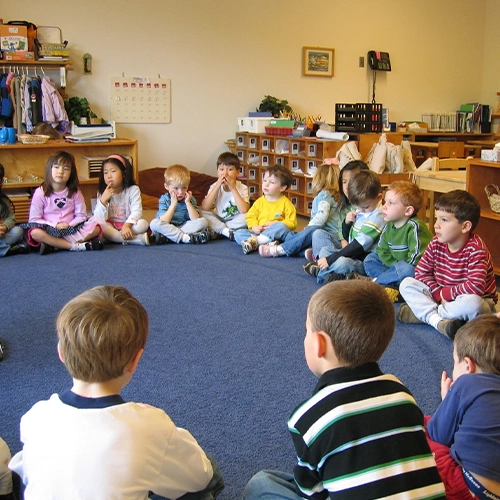
완벽한 몬테소리 교실 배치는 자립 학습을 지원하고, 공동체 의식을 함양하며, 아이들의 발달적 요구를 충족합니다. 세심한 디자인과 구성은 실용적이고 매력적인 학습 환경을 조성하는 데 필수적입니다. 위에서 설명한 필수 요소들을 고려하면 교육 경험을 향상시키는 몬테소리 교실을 만들 수 있습니다. 적절한 배치는 학업적 성장을 지원하고 사회정서적 발달을 촉진하여 아이들이 평생 학습과 성공을 준비할 수 있도록 도와줍니다.
몬테소리 교실 배치의 장점은 무엇입니까?
몬테소리 교실 배치는 독립심, 창의성, 그리고 집중력을 키우는 환경을 조성하여 학습 효과를 높입니다. 그렇다면 이 배치의 구체적인 이점은 무엇일까요?
각 활동에 대한 지정된 영역을 만듭니다
몬테소리 교실은 읽기, 실생활, 미술 등 다양한 활동을 위한 특정 공간을 제공합니다. 이러한 구성은 아이들이 학습 자료와 활동의 위치를 파악하여 자립심과 책임감을 기르도록 돕습니다. 지정된 공간을 통해 아이들은 한 번에 한 가지 활동에만 집중할 수 있어 주의가 산만해지는 것을 줄이고 학습 경험을 향상시킬 수 있습니다.
지정된 공간은 아이들이 의미 있는 활동에 참여할 수 있는 체계적인 환경을 조성하는 데 도움이 됩니다. 각 공간은 탐구와 발견을 장려하도록 세심하게 배치되어 있습니다. 예를 들어, 실생활 공간에는 붓기, 숟가락질, 청소 도구가 포함될 수 있으며, 독서 공간에는 다양한 책이 비치된 아늑한 공간이 마련되어 있습니다. 이러한 세밀한 공간 구분은 학습에 도움이 될 뿐만 아니라, 아이들의 조직력과 질서 의식 발달에도 도움이 됩니다.
Now that we’ve discussed the importance of zoning, let’s explore what specific learning areas are usually included in a Montessori classroom layout.
Creating Learning Zones in Your Montessori Classroom Layout
A well-organized Montessori classroom layout separates the space into different areas, each dedicated to a specific type of learning. No matter if you’re working on a Montessori preschool classroom layout or designing a Montessori elementary classroom layout, the idea of clear, calm zones stays the same.
Here are the main zones you should plan for in your Montessori classroom layout:
- Practical Life Area
This space includes activities that teach daily living skills, like pouring, sweeping, and buttoning. Materials here often include child-sized pitchers, cleaning tools, and dressing frames. It’s a key part of any Montessori primary classroom layout and helps children build independence and concentration.
- Sensorial Area
A must-have in every layout of a Montessori classroom, this area features materials that help children refine their senses, such as texture boards, color tablets, and sound cylinders.
- Language Area
This zone supports early reading, writing, and communication. Simple materials like sandpaper letters, movable alphabets, and beginner readers fit well here. Whether you’re setting up a Montessori kindergarten classroom layout or a first-grade Montessori classroom layout, the language area should feel cozy and inviting.
- Math Area
Hands-on materials for counting, addition, subtraction, and basic geometry belong here. Bead chains, number rods, and golden beads are common examples. A strong math area is part of a well-rounded Montessori classroom layout elementary plan.
- Cultural Area
Introduce children to geography, science, art, and history through hands-on materials like globes, puzzle maps, and science experiment kits. No matter if it’s a Montessori toddler classroom layout or a Montessori preschool classroom layout, a small cultural section can spark considerable curiosity.
- 조용한 독서 코너
In any Montessori classroom layout, a cozy nook with soft lighting, a few floor cushions, and simple bookshelves encourages a love of reading.
Example Learning Zone Setup for Different Ages
| 연령대 | Key Learning Zones |
|---|---|
| Infant/Toddler | Practical Life, Sensorial Exploration, Soft Movement Areas |
| Primary (3-6 years) | Full Zones: Practical Life, Sensorial, Language, Math, Cultural |
| Lower Elementary | Expanded Zones: Advanced Math, Science Experiments, Research Areas |
| Upper Elementary | Project-Based Work Areas, Collaborative Learning Spaces |
지정된 구역의 이점
- 집중력을 향상시킵니다: 아이들은 다른 자료에 방해받지 않고 한 번에 한 가지 활동에만 집중할 수 있습니다.
- 책임감을 장려합니다: 재료의 위치를 아는 것은 환경에 대한 책임감과 배려심을 키워줍니다.
- 학습을 촉진합니다: 정해진 공간이 있으면 아이들이 주변 환경을 탐색하고 참여하는 것이 더 쉬워집니다.
Tips for Setting Up Zones
- Keep pathways clear to allow free movement.
- Make each zone easy for children to access and use independently.
- Use low shelves or small rugs to visually separate areas without building walls.
If you’re planning the layout of Montessori classroom spaces for different age groups, remember that flexibility is key. As children grow, the classroom should be easy to adjust to meet their changing needs.
어린이용 가구 및 재료 사용
몬테소리 교실 구성의 핵심은 어린이 크기에 맞는 가구와 재료를 사용하는 것입니다. 이러한 접근 방식은 모든 것이 어린이에게 접근하기 편리하도록 하여 학습 환경을 스스로 주도할 수 있도록 합니다. 어린이 크기에 맞는 테이블, 의자, 선반은 아이들이 자유롭게 움직이고 스스로 활동을 선택할 수 있도록 하여 소유감과 자신감을 키워줍니다.
Children who can easily reach and use materials are more likely to engage in activities and develop fine motor skills. This accessibility also supports the Montessori principle of independence, allowing children to perform tasks without constant adult assistance. Moreover, child-sized furniture is safer and more comfortable for children, reducing the risk of accidents and enhancing their overall well-being.
어린이용 가구의 장점
- 어린이에게 힘을 실어줍니다: Enables children to access and use materials, fostering their independence and self-reliance.
- 참여를 강화합니다: Children are more likely to participate in activities within their reach.
- 안전성 향상: 적절한 크기의 가구는 넘어짐이나 기타 사고의 위험을 줄여줍니다.
Furniture choices play a huge role in shaping the Montessori classroom layout. Picking the right pieces helps create a space that encourages independence and focus.
Essential Furniture for an Effective Montessori Classroom Layout
Setting up the right furniture is key to designing a supportive Montessori classroom layout. Whether you are working on a Montessori preschool classroom layout, a Montessori toddler classroom layout, or even planning a Montessori elementary classroom layout, the basics stay the same: everything should be child-friendly, accessible, and simple.
Here are the essential furniture elements every Montessori space needs:
- Low Open Shelves
Low shelves are a must in any layout of a Montessori classroom. They allow children to easily choose and return materials, which builds independence from a young age. Whether you’re planning a Montessori primary classroom layout or a Montessori infant classroom layout, open shelving keeps the environment organized and calm.
- Child-Sized Tables and Chairs
In any Montessori school classroom layout, tables and chairs should fit the size of the children. Smaller furniture promotes good posture and allows easy movement, a significant part of creating a child-centered environment.
- Floor Mats
Mats give children personal space for floor activities. In smaller setups like a small toddler classroom layout Montessori, providing enough mats helps balance limited table space.
- 천연 소재
Wooden furniture and neutral colors are preferred across all types of Montessori layouts—from the Montessori kindergarten classroom layout to the first grade classroom layout, and Montessori designs. Natural elements help create a calming atmosphere.
- Accessible Storage Units
Proper storage is essential, especially when planning a Montessori classroom layout, for elementary, or looking for Montessori classroom layout ideas. Open cubbies, labeled baskets, and trays help children keep their environment tidy.
Furniture Essentials at Different Montessori Levels
| Montessori Level | Key Furniture Focus |
|---|---|
| Infant | Soft mats, low shelves, small baskets |
| Toddler | Low tables, open shelves, floor work mats |
| Primary (ages 3-6) | Various sized tables, reading nooks, practical life stations |
| Lower Elementary | Group tables, project spaces, organized shelf units |
| Upper Elementary | Work desks, collaborative spaces, advanced material shelves |
If you’re looking for Montessori classroom layout pictures or more real-life examples, platforms like Pinterest’s Montessori classroom layout boards can provide plenty of creative ideas.
But if you want to see real, professionally designed Montessori spaces, check out our project gallery featuring actual classrooms with thoughtful layouts and beautiful materials. Visit Our Montessori Classroom Projects to get even more Montessori classroom layout inspo!
꿈만 꾸지 말고, 직접 디자인하세요! 맞춤 가구에 대한 니즈를 함께 이야기 나눠요!
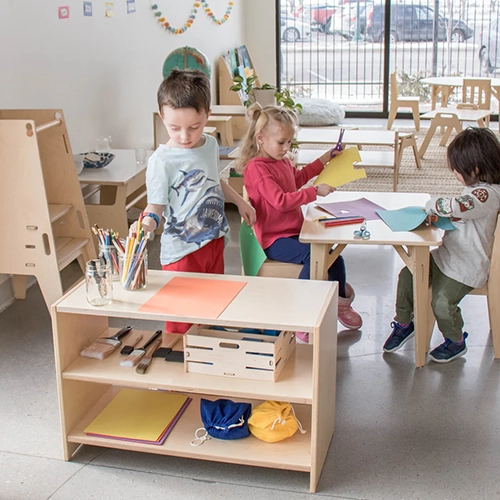
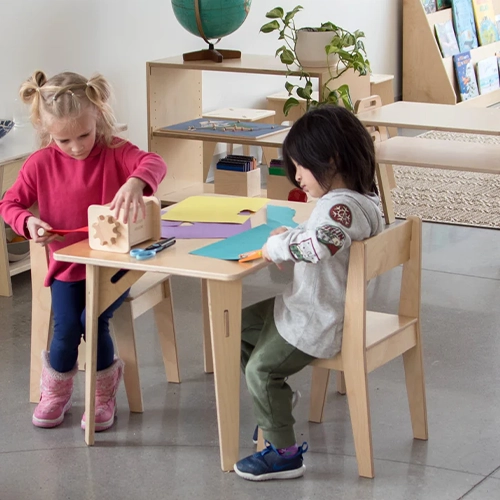
교실을 정돈하고 깔끔하게 유지하세요
몬테소리 교실 구조에는 정돈되고 깔끔한 환경이 필수적입니다. 깔끔하고 개방적인 공간은 아이들이 방해받지 않고 활동에 집중할 수 있도록 해줍니다. 적절한 수납 솔루션과 미니멀한 접근 방식은 질서를 유지하는 데 도움이 되어 아이들이 집중하고 효과적으로 학습할 수 있도록 도와줍니다.
어수선하지 않은 환경은 학습에 도움이 되는 차분하고 평화로운 분위기를 조성합니다. 모든 것이 제자리에 있으면 아이들은 쉽게 자료를 찾고 반납할 수 있어 좌절감을 줄이고 자립심을 키울 수 있습니다. 또한, 정돈된 공간은 질서와 규율에 대한 몬테소리의 강조를 반영하여 아이들이 이러한 필수적인 생활 기술을 발달시키는 데 도움이 됩니다.
자연적 요소와 감각적 경험을 통합하세요
Incorporating natural elements, such as plants, natural light, and sensory materials, enhances the Montessori classroom layout. These elements create a calm and inviting atmosphere, improving children’s mood and concentration. Sensory experiences with textures, colors, and sounds help develop children’s sensory perception and cognitive skills.
자연에서 영감을 받은 교실은 아이들이 자연과 교감하고, 주변 환경을 소중히 여기고 아끼도록 돕습니다. 자연광은 기분과 생산성을 높이는 것으로 나타났으며, 감각적인 소재는 아이들의 감각을 자극하고 인지 발달을 돕습니다. 나무 장난감, 부드러운 천, 차분한 색상과 같은 요소들은 따뜻하고 따뜻한 학습 환경을 조성합니다.
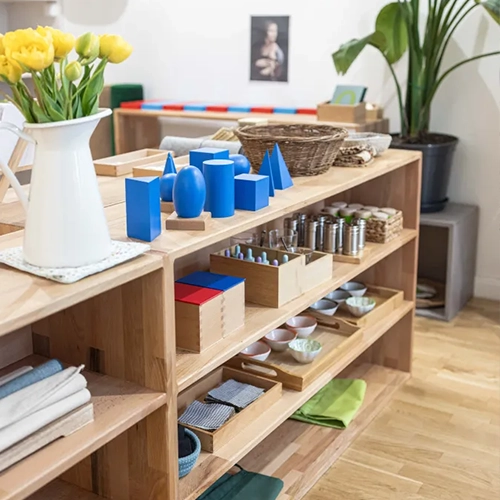
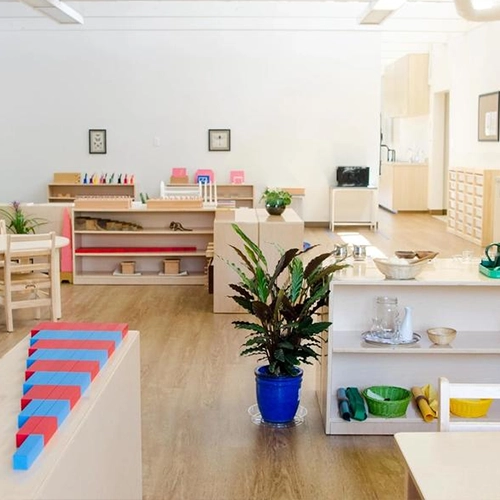
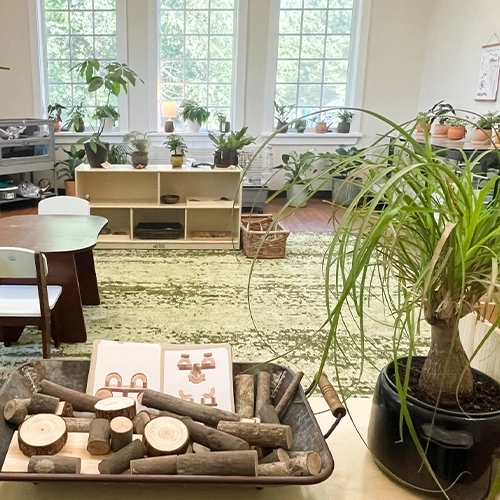
유연성과 자유로운 이동을 허용합니다
몬테소리 교실 구조의 중요한 장점은 유연성과 자유로운 이동입니다. 이러한 구조는 아이들이 자유롭게 움직이고 활동을 선택할 수 있도록 하여 독립심과 자기 주도성을 함양합니다. 유연한 좌석 배치와 개방적인 공간은 개별 학습부터 그룹 프로젝트까지 다양한 학습 활동을 가능하게 하여 다양한 학습 스타일과 필요에 맞춰 활용할 수 있습니다.
이러한 유연성은 몬테소리 교육이 강조하는 자기 주도 학습을 뒷받침하여 아이들이 자신의 관심사를 따르고 독립적으로 학습할 수 있도록 합니다. 열린 공간은 유아 발달에 필수적인 신체 활동과 탐구를 장려합니다. 또한, 유연한 배치는 다양한 교수법과 활동에 맞춰 조정 가능하여 교실을 역동적이고 다재다능한 학습 환경으로 만들어 줍니다.
A Montessori classroom layout provides numerous benefits, including designated activity areas, child-sized furniture, organized and clutter-free spaces, natural elements, and flexibility. These features create an environment that supports children’s independent, focused, and joyful learning. By embracing these principles, educators can create a space that enhances the educational experience. The proper layout supports academic growth and nurtures social and emotional development, preparing children for lifelong learning and success.
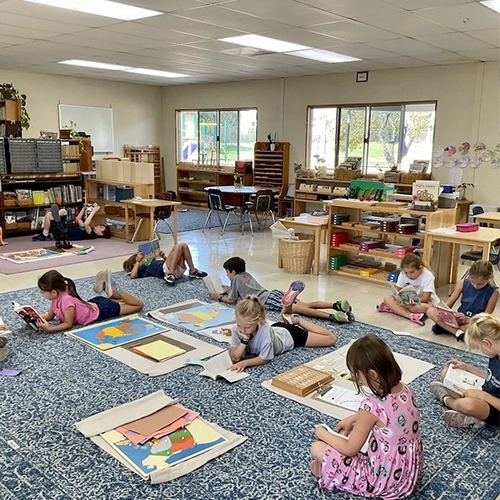
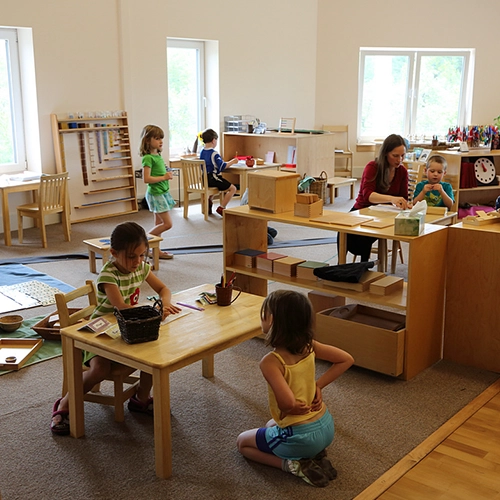
While planning a Montessori classroom layout, it’s just as important to know what mistakes to avoid as it is to know what to include.
Mistakes to Avoid When Designing a Montessori Classroom Layout
Designing a Montessori classroom layout takes careful thought. Even with the best intentions, it’s easy to make small mistakes that can affect how well the environment supports children’s learning and independence. Here are some common pitfalls to watch out for:
- Overcrowding the Space
One of the biggest mistakes is trying to fit too much into a limited area. Whether you’re setting up a Montessori preschool classroom layout or a Montessori toddler classroom layout, every item should have a clear purpose. Too much furniture or too many materials can overwhelm children and make the space feel chaotic. Always prioritize open floor areas for unrestricted movement.
- Ignoring Flow and Movement Paths
A good floor plan for a Montessori classroom layout considers how children move through the space. Furniture should be arranged to create natural walking paths without obstacles. Crowded or blocked walkways interrupt children’s concentration and independence.
- Not Updating the Layout as Children Grow
The needs of a Montessori primary classroom layout differ significantly from those of a Montessori elementary classroom layout. Failing to adjust the environment as children grow can limit their learning opportunities. Regularly reassess the setup to match children’s developing skills and interests.
- Placing Materials Out of Reach
In the layout of a Montessori classroom, everything should be accessible to children without needing adult help. Shelves that are too high or heavy furniture that children can’t move defeat the Montessori goal of promoting independence.
- Over-Decorating the Space
While a warm, inviting atmosphere is essential, overloading the walls with posters, bright colors, or too much visual clutter can be distracting. A simple, calm design helps children focus better, a key principle behind effective Montessori classroom layouts.
Quick Checklist to Avoid Common Layout Mistakes
| Mistake | How to Fix It |
|---|---|
| Overcrowded furniture | Remove non-essential items and create open areas |
| Blocked pathways | Keep all materials within the child’s reach |
| Static layout | Update zones and materials as children grow |
| High shelves | Keep all materials within child’s reach |
| Visual clutter | Stick to neutral tones and minimal decoration |
A well-planned Montessori classroom layout isn’t just about making a space look good — it plays a fundamental role in supporting children’s growth and development.
How Montessori Classroom Layout Supports Child Development
The Montessori classroom layout is carefully designed to nurture every part of a child’s development — from physical movement to emotional confidence and cognitive skills. When done right, the layout itself becomes a silent teacher in the classroom.
- 독립을 장려합니다
One of the main goals of any Montessori preschool classroom layout or Montessori primary classroom layout is to help children do things by themselves. Low shelves, child-sized furniture, and clearly labeled materials let kids choose, use, and put away work without adult help. This builds their self-confidence and decision-making skills early on.
- Fosters Focus and Concentration
A simple, uncluttered layout of a Montessori classroom helps children concentrate. When each area is clearly defined and materials are neatly arranged, children can stay focused longer. Whether it’s a small toddler classroom layout, a Montessori classroom layout, or a Montessori elementary classroom layout, a calm space always supports deeper learning.
- 신체 발달을 촉진합니다
Montessori classrooms encourage movement. With open floors and easy-to-navigate zones, children naturally develop better balance, coordination, and gross motor skills. In designs like the floor plan of a Montessori classroom layout, freedom of movement is built right into the environment.
- Supports Social Skills
Thoughtful layout planning, like providing space for small group activities or quiet one-on-one work, helps children practice social interactions. Even a Montessori kindergarten classroom layout can subtly guide children toward cooperation, sharing, and respectful communication.
- Stimulates Natural Curiosity
When materials are displayed beautifully and invitingly, children feel drawn to explore and learn. A well-thought-out classroom Montessori layout encourages children to ask questions, try new things, and develop a love of learning that lasts a lifetime.
How Layout Shapes Development
| Area of Growth | Layout Feature |
|---|---|
| 독립 | Low shelves, child-accessible materials |
| 집중하다 | Clear zones, simple decor |
| Physical Skills | Open movement paths |
| 사회적 기술 | Group tables, small work areas |
| Curiosity | Well-organized, attractive material displays |
몬테소리 교실을 만드는 방법은?
몬테소리 교실 레이아웃을 만드는 데는 독립심, 창의성, 그리고 학습에 대한 열정을 북돋아 주는 환경을 조성하기 위한 신중한 계획과 설계가 필요합니다. 완벽한 몬테소리 교실 레이아웃을 설계하는 데 도움이 되는 핵심 요소와 아이디어는 다음과 같습니다.
몬테소리 교실 레이아웃 철학
몬테소리 교실 배치 철학은 독립심, 탐구심, 그리고 전인적 발달을 촉진하는 환경 조성에 중점을 둡니다. 아동 중심적인 설계로 가구부터 학습 자료까지 모든 것이 아동의 크기와 필요에 맞춰 조정됩니다. 이러한 접근성은 아동이 스스로 활동을 선택하고 공간을 자유롭게 탐색할 수 있도록 하여 소유감과 자신감을 키워줍니다. 각 물건에 정해진 자리가 있는 정돈되고 정돈된 환경은 필수적이며, 이는 아동이 주의 산만을 줄이고 학습에 집중할 수 있도록 도와줍니다. 자연광과 재료는 학습과 웰빙을 증진하는 차분하고 매력적인 분위기를 조성합니다.
식물이나 천연 재료와 같은 자연 요소를 활용하는 것도 몬테소리 교실 배치에 매우 중요합니다. 이러한 요소들은 공간을 더욱 매력적으로 만들고, 아이들이 주변 환경을 소중히 여기고 아끼도록 돕습니다. 몬테소리 교실 배치에는 감각 활동과 실생활 활동을 위한 전용 공간이 마련되어 있어 아이들이 직접 체험하며 운동 능력과 감각 지각을 발달시킬 수 있습니다. 또한, 다양한 교수법과 학습 스타일을 수용할 수 있는 유연성과 적응성을 갖춘 배치는 역동적이고 몰입적인 학습 환경을 조성합니다. 몬테소리 교실 배치 철학은 각 아이의 지적, 정서적, 신체적 성장을 지원하는 양육적인 공간을 조성하는 것을 목표로 합니다.
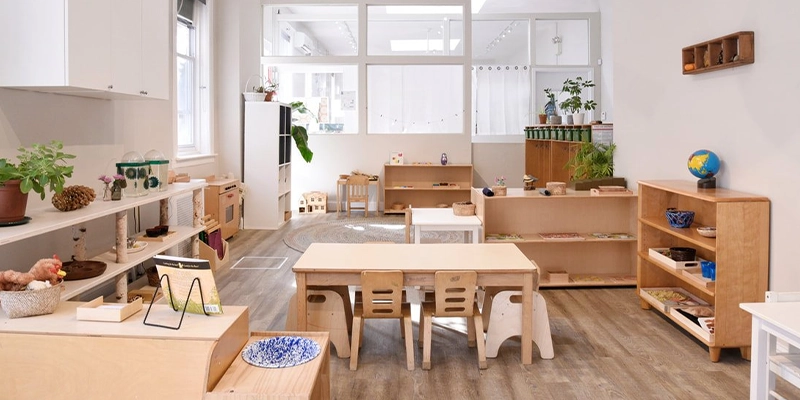
몬테소리 교실 디자인 아이디어
자연광과 중성색에 집중하세요
자연광은 몬테소리 교실 배치에서 중요한 역할을 합니다. 밝고 통풍이 잘 되는 공간은 분위기와 집중력을 높여 학습 환경을 더욱 쾌적하고 효과적으로 만들어 줍니다. 벽과 가구의 중립적인 색상은 차분하고 편안한 분위기를 조성하여 학습 자료와 아이들의 활동이 감각을 압도하지 않으면서도 돋보이도록 합니다.
자연광은 아이들의 일주기 리듬을 조절하여 수면의 질을 향상시키고 전반적인 웰빙을 증진하는 데 도움이 됩니다. 중성색과 함께 사용하면 고요하고 집중이 잘 되는 환경을 조성하여 방해 요소와 과도한 자극을 최소화합니다. 벽과 가구에 중성색을 사용하면 몬테소리 교육 자료의 생동감 넘치는 색상이 더욱 돋보여 아이들이 더욱 매력적이고 몰입하게 됩니다.
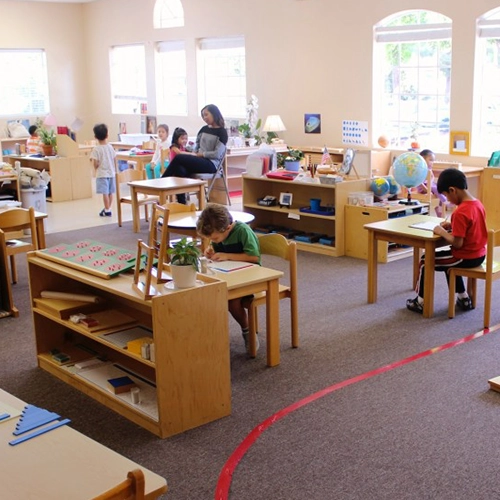
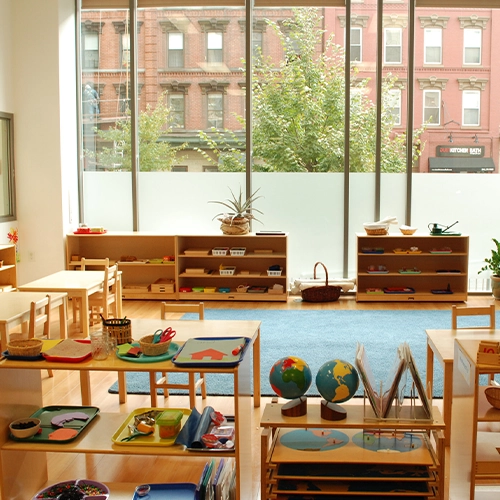
천연 소재와 식물을 통합하세요
나무, 면, 양모와 같은 천연 소재와 식물을 함께 사용하면 교실에 자연의 느낌을 더할 수 있습니다. 이는 공간을 더욱 아늑하게 만들고, 아이들이 주변 환경을 소중히 여기고 아끼는 마음을 갖게 합니다. 식물은 공기의 질을 개선하고, 아이들이 직접 체험하며 생물학과 생태학에 대해 배울 수 있는 기회를 제공합니다.
천연 소재는 합성 소재와는 다른 질감과 따뜻함을 제공하여 감각적인 이점을 제공합니다. 이러한 자연과의 연결은 아이의 신체적, 정서적, 지적 발달을 돕는 환경을 조성한다는 몬테소리 철학을 뒷받침합니다. 아이들은 식물을 돌보고, 책임감을 배우고, 식물 생물학의 기본 원리를 익히는 데 참여할 수 있습니다.
질서와 조직감을 만들어라
몬테소리 교실은 생산적인 학습 환경을 조성하는 데 매우 중요합니다. 각 물건은 정해진 자리에 있어야 하고, 자료는 논리적으로 배열되어야 합니다. 이러한 체계적인 구성은 아이들이 질서의 개념을 이해하고, 방해 요소를 줄이며, 활동에 더 쉽게 집중할 수 있도록 도와줍니다. 깔끔하고 개방적인 공간은 어수선함을 피하고 차분한 분위기를 조성하는 데 필수적입니다.
아이들은 예측 가능하고 질서 있는 환경에서 잘 자랍니다. 모든 것이 제자리에 있고 사용 후 제자리에 있을 때, 아이들은 책임감과 환경에 대한 존중심을 배우게 됩니다. 열린 선반, 라벨이 붙은 용기, 그리고 명확하게 구분된 활동 영역은 아이들이 교실을 독립적이고 자신감 있게 탐색하는 데 도움이 됩니다.

접근 가능하고 매력적인 학습 자료 제공
몬테소리 교실의 자료는 아이들이 쉽게 접근할 수 있어야 합니다. 낮은 선반과 적절한 크기의 가구는 아이들이 스스로 자료를 찾고 가져올 수 있도록 하여 자립심을 기르도록 도와줍니다. 학습 자료는 흥미를 유발하고, 스스로 교정할 수 있어야 하며, 실용적인 생활 활동부터 복잡한 인지 과제까지 특정 기술을 발달시키도록 설계되어야 합니다.
접근 가능한 자료는 아이들이 학습에 대한 선택을 할 수 있도록 해줍니다. 아이들은 스스로 활동을 선택함으로써 의사결정 능력과 내재적 동기를 발달시킵니다. 자기 교정 자료는 아이들이 어른의 끊임없는 개입 없이도 자신의 실수를 통해 배우고 자신감과 문제 해결 능력을 키울 수 있도록 도와줍니다.
공동체 의식과 협력을 강화하세요
Creating spaces that encourage community and collaboration is vital to the Montessori classroom layout. Group seating areas, round tables, and cozy reading nooks allow children to collaborate, share ideas, and build social skills. These areas should be flexible, allowing for various group sizes and activities, from collaborative projects to group discussions.
협력적인 공간은 아이들에게 함께 일하고 타인의 아이디어를 존중하는 것의 중요성을 가르칩니다. 이러한 상호작용은 아이들의 미래에 필수적인 소통 능력과 팀워크를 함양합니다. 공동체 중심적인 환경을 조성하면 아이들은 공감 능력과 소속감을 키울 수 있습니다.
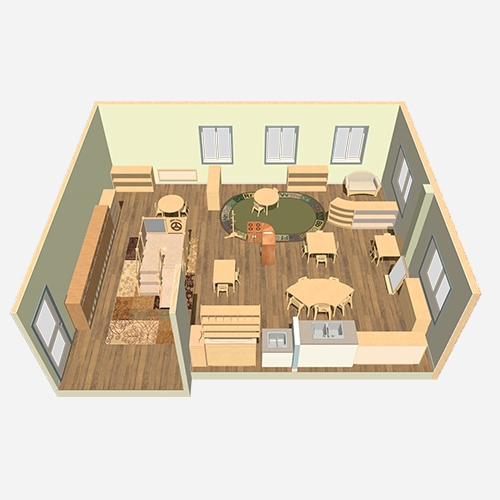


몬테소리 교실 레이아웃을 설계하려면 자연 요소, 구성, 접근성, 그리고 공동체 형성에 주의를 기울여야 합니다. 이러한 중요한 측면에 집중하면 몬테소리 철학을 뒷받침하고 아이들의 자립심, 참여도, 그리고 즐거운 학습을 촉진하는 학습 환경을 조성할 수 있습니다. 교육자는 사려 깊은 설계를 통해 아이의 전인적 성장을 도모하고 평생의 성공을 준비시키는 공간을 조성할 수 있습니다.
왜 몬테소리 교실 배치를 도입해야 할까요?
몬테소리 교실 환경을 도입하면 아이들의 학습 경험을 향상시키는 수많은 이점을 얻을 수 있습니다. 몬테소리 교실 환경은 독립심, 창의력, 그리고 학습에 대한 열정을 키워줍니다. 아이들은 아이 중심적이고, 잘 정돈되어 있으며, 미적으로 아름다운 환경을 조성함으로써 주변 환경을 탐구하고 참여하도록 장려됩니다.
몬테소리 교실은 어린이의 크기에 맞는 가구와 쉽게 접할 수 있는 재료를 활용하여 자율성을 증진합니다. 낮은 선반과 열린 공간은 아이들이 스스로 재료를 선택하고 반납할 수 있도록 하여 책임감과 자신감을 키워줍니다. 자연광과 중립적인 색상은 차분하고 아늑한 분위기를 조성하여 집중력과 웰빙을 향상시킵니다. 또한, 식물과 나무 재료와 같은 자연 요소를 활용하여 아이들이 자연과 더욱 가까워지고 환경 의식을 함양할 수 있도록 합니다.
몬테소리 교실 구조는 질서와 정리를 강조하여 아이들이 방해 요소를 줄이고 학습에 더욱 집중할 수 있도록 도와줍니다. 각 물건은 정해진 자리에 놓여 있어 아이들에게 질서의 중요성을 가르치고 정리 능력을 발달시키는 데 도움을 줍니다. 유연하고 적응력 있는 구조는 다양한 교수법과 학습 스타일을 수용하여 역동적이고 몰입적인 학습 환경을 조성합니다.
몬테소리 교실 구조를 채택하면 어린이의 지적, 정서적, 신체적 발달이 촉진되어 미래의 성공과 평생 학습에 대비할 수 있습니다.
몬테소리 교실 vs 전통 교실
몬테소리 교실 배치는 여러 가지 중요한 면에서 전통적인 교실 환경과 크게 다릅니다. 몬테소리 교실 배치는 아동 중심 설계, 유연성, 그리고 자연 재료를 강조합니다. 동시에, 전통적인 교실은 교사 중심의 배치, 고정된 구조, 그리고 교과서와 학습지에 의존하는 경향이 있습니다. 이러한 차이점은 전인적 발달과 자기 주도적 학습을 촉진하는 몬테소리 접근법의 고유한 장점을 강조합니다.
몬테소리 교실에서는 아이들이 스스로 활동을 선택하고 자신의 속도에 맞춰 학습할 수 있어 독립심과 깊은 참여를 촉진합니다. 전통적인 교실은 교사 주도의 엄격한 교육 과정을 따르기 때문에 창의성과 개별 탐구력이 제한될 수 있습니다. 몬테소리 환경에서 교사의 역할은 지시하기보다는 안내하고 촉진하여 협력적인 학습 환경을 조성하는 것입니다.
Montessori materials are designed to be self-correcting and hands-on, promoting active learning and problem-solving, while traditional classrooms often use less interactive learning tools. The Montessori layout encourages social interaction through mixed-age groupings, enhancing peer learning and cooperation. In contrast, traditional classrooms usually group students by age and may promote a more competitive atmosphere.
전반적으로 몬테소리 교실 배치는 독립적인 학습, 창의성, 전인적 발달을 지원하는 양육적이고 역동적인 환경을 제공하며, 전통적인 교실 환경에 비해 상당한 이점을 제공합니다.
이 섹션에 대한 자세한 내용은 다음 기사를 참조하세요. 몬테소리 학교 vs. 전통 학교.
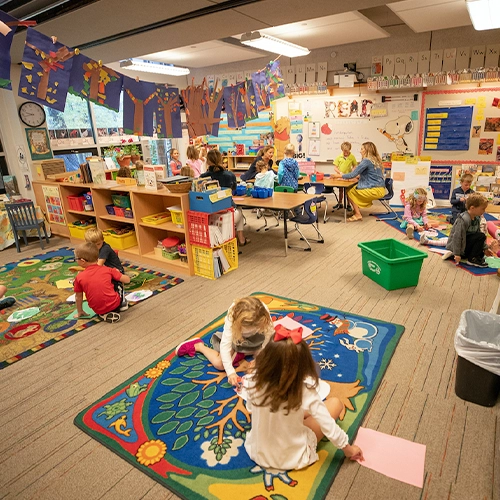
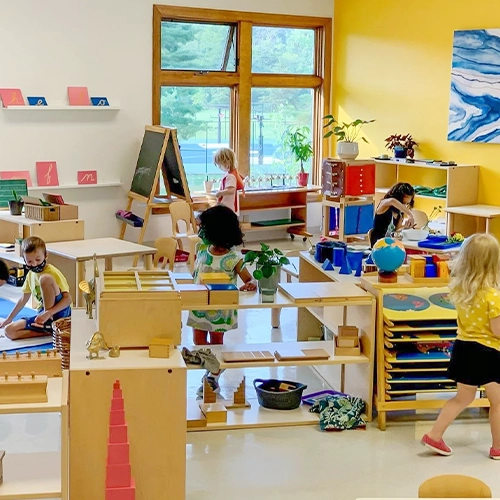
결론
A thoughtfully designed Montessori classroom layout does more than organize a space — it creates an environment where independence, focus, creativity, and community naturally thrive. Every detail, from low shelves to cozy reading corners and clear movement paths, plays a part in shaping a child’s daily experiences and long-term growth.
By understanding the key principles of Montessori design and carefully planning each learning zone, you can build a classroom that truly honors each child’s journey toward self-discovery. Whether you’re working on a small toddler space or a complete Montessori elementary classroom layout, the heart of the design remains the same: trust the child’s ability to learn, explore, and grow within a prepared and beautiful environment.
Ready to bring your vision to life? Start with thoughtful choices—and create a Montessori classroom layout that inspires every day.
자주 묻는 질문
What is the typical layout of a Montessori classroom?
A typical Montessori classroom layout features open spaces, clearly defined learning zones, low shelves with accessible materials, and plenty of natural light. Whether in a Montessori preschool classroom layout or a Montessori elementary classroom layout, the environment is always calm, organized, and child-centered.
How do I create a small Montessori classroom layout?
If you’re working with limited space, focus on just a few essential learning zones and keep materials to a minimum. Use multi-functional furniture and maximize floor work areas. Look at a small toddler classroom layout Montessori ideas for inspiration on using compact spaces effectively.
What should I include in a Montessori toddler classroom layout?
A Montessori toddler classroom layout should have low shelves, simple practical life activities (like pouring and scooping), sensory materials, and cozy spaces for quiet play. Open areas for movement are also key at this stage.
How often should a Montessori classroom layout change?
The layout doesn’t need constant major changes, but it should evolve with the children. As they grow or new interests emerge, you can adjust material displays and rearrange zones. A flexible Montessori classroom layout, elementary, allows for easy updates without confusing the children.
Where can I find ideas for a Montessori classroom layout?
Great resources include browsing Pinterest Montessori classroom layout boards, checking Montessori classroom layout pictures online, or looking at real-world Montessori classroom layout sample designs shared by schools.
What’s the best way to plan the Montessori elementary classroom layout?
Start by understanding the specific needs of elementary-age children: more group projects, independent research, and collaborative work. When planning the Montessori elementary classroom layout, the plan should balance personal workspaces with areas for teamwork, plus access to advanced learning materials.

